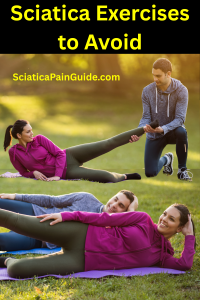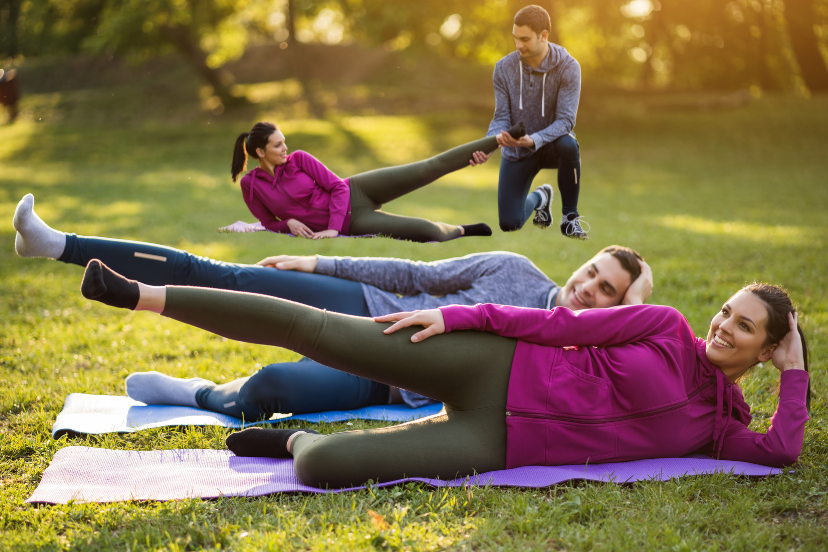Sciatica Exercises to Avoid: Protect Your Back and Find Real Relief
If you’re struggling with sciatic nerve pain in the leg, you know how even simple movements can trigger sharp, shooting pain or lingering numbness. Many people turn to stretching or exercise for relief, only to find that certain moves actually make their lower back pain and sciatica worse. Knowing the sciatica exercises to avoid is just as important as learning the right ones. The wrong stretches or workouts can put pressure on the sciatic nerve, worsen sciatica flare ups, and slow your recovery. In this guide, we’ll cover which exercises may aggravate your condition, explain why they’re harmful, and give you safer alternatives to try at home.
Why Some Exercises Can Worsen Sciatica
The sciatic nerve runs from the lower spine down through the hips, buttocks, and legs. When compressed or irritated—often from a herniated disc, piriformis syndrome, or sciatic nerve compression—it can cause pain, tingling, or weakness.
Specific exercises overstretch or overload the lower back and hips, increasing nerve irritation. For sciatica sufferers, this can mean:
-
Increased inflammation around the nerve
-
Worsening leg pain during or after exercise
-
Prolonged recovery time from flare-ups
-
Greater risk of developing chronic sciatica
That’s why it’s essential to know which movements to avoid and replace them with safer alternatives.
Common Sciatica Exercises to Avoid
Here are the top exercises that can make sciatica worse, especially during flare-ups.
1. Toe Touches and Forward Bends
-
Why to avoid: Bending forward puts significant pressure on the spinal discs, which can worsen a herniated disc sciatica. It also stretches the hamstrings aggressively, pulling on the lower back.
-
Better alternative: Try gentle hamstring stretches lying down with a strap or towel, which lengthen the muscle without straining the back.
2. Sit-Ups and Crunches
-
Why to avoid: Traditional ab workouts increase stress on the lower spine and can aggravate sciatic nerve compression.
-
Better alternative: Do pelvic tilts or dead bugs, which strengthen the core without rounding the lower back.
3. Heavy Weightlifting (Squats, Deadlifts, Leg Press)
-
Why to avoid: While strength training is beneficial, heavy lifting—especially with poor form—compresses the spine and irritates the sciatic nerve.
-
Better alternative: Light resistance training with bands or bodyweight, such as glute bridges or bird dogs, provides strengthening with less strain.
4. Double Leg Lifts
-
Why to avoid: Raising both legs off the ground simultaneously puts stress on the lumbar spine.
-
Better alternative: Single-leg lifts with the other knee bent to support the lower back.
5. High-Impact Activities (Running, Jumping, HIIT)
-
Why to avoid: Repetitive pounding from running or high-impact workouts can irritate already inflamed nerves.
-
Better alternative: Low-impact activities such as walking with sciatica pain, swimming, or cycling on a recumbent bike.
6. Twisting Yoga Poses
-
Why to avoid: Deep spinal twists may worsen nerve irritation and inflame surrounding tissues.
-
Better alternative: Gentle child’s pose or cat-cow stretches to improve mobility without twisting the spine.
7. Straight-Leg Sit-and-Reach Stretches
-
Why to avoid: Similar to toe touches, these stretches overstretch the hamstrings and pull the lower back into flexion, making sciatica pain worse.
-
Better alternative: Seated hamstring stretch with one leg bent, keeping the back straight.
Safer Alternatives for Sciatica Pain Relief
Instead of harmful moves, focus on sciatica stretches at home and exercises that relieve tension and support healing.
Gentle Stretches
-
Knee-to-chest stretch – Helps open the lower back.
-
Piriformis stretch – Relieves tension from piriformis syndrome sciatica.
-
Figure 4 stretch – Opens the hips without overstraining.
Low-Impact Strengthening
-
Pelvic tilts – Strengthen core muscles and stabilize the spine.
-
Clamshells – Target hip stabilizers without stressing the lower back.
-
Bird dogs – Strengthen core and glutes while protecting the spine.
Everyday Activities That Feel Like Exercises to Avoid
It’s not only workouts that can aggravate sciatica—daily habits matter too.
-
Sitting with sciatica: Long hours in the car or office can worsen pain. Use a lumbar cushion and take breaks to stand and stretch.
-
Lifting improperly: Bending at the waist to pick things up strains the lower back. Instead, squat down and lift with your legs.
-
Poor posture while walking: Walking slouched or with uneven weight distribution can make sciatica pain running down leg worse.
How to Prevent Sciatica Flare-Ups During Exercise
-
Warm up with gentle stretching before activity.
-
Avoid sudden increases in intensity—progress gradually.
-
Strengthen your core and glutes to support spinal health.
-
Alternate between heat or ice for sciatica after workouts to reduce inflammation.
-
Listen to your body—if a move triggers sharp pain, stop immediately.
Lifestyle Tips for Safer Workouts
-
Use supportive shoes: Good footwear helps reduce impact on the spine.
-
Try natural remedies for sciatica: Techniques like yoga, breathing, massage, and Epsom salt baths can help.
-
Incorporate rest days: Your body needs recovery to heal nerve irritation.
-
Consider professional help: Sciatica physical therapy can design a customized program that avoids harmful movements.
When to See a Doctor
While avoiding harmful exercises can help, sometimes professional care is necessary. Seek medical help if:
-
Pain becomes severe or persistent despite home remedies.
-
You notice numbness, weakness, or tingling spreading in the legs.
-
You lose bladder or bowel control (a medical emergency).
-
Sciatica pain interferes with sleep, driving, or daily function.
A U.S. healthcare provider may recommend physical therapy, imaging, or pain management treatments to get to the root cause.
FAQs About Sciatica Exercises to Avoid
1. What exercises should you not do with sciatica?
Avoid toe touches, sit-ups, heavy lifting, high-impact running, and twisting yoga poses, as these can worsen nerve irritation.
2. Can exercise make sciatica worse?
Yes, the wrong exercises can increase inflammation and compression of the sciatic nerve. Always choose low-impact, spine-friendly movements.
3. Is walking bad for sciatica?
Walking is generally safe and even helpful for sciatica, as long as you maintain good posture and avoid overexertion.
4. Are squats bad for sciatica?
Heavy squats can put pressure on the lower back and worsen symptoms. Light bodyweight squats may be tolerated if done carefully.
5. Which yoga poses should I avoid with sciatica?
Deep twists, forward folds, and seated straight-leg stretches should be avoided. Gentle hip openers and back mobility poses are safer.
6. What’s the best type of exercise for sciatica relief?
Low-impact activities like swimming, stationary cycling, and core strengthening help reduce pressure on the sciatic nerve, or try these simple stretches.
7. Should I stop exercising if I have sciatica?
Not necessarily—exercise can be part of healing. The key is to avoid harmful moves and focus on safe alternatives guided by a physical therapist.
Sciatica Exercises to Avoid – Conclusion
Finding the right balance between activity and rest is essential for sciatica sufferers. By knowing the sciatica exercises to avoid, you can prevent flare-ups, protect your spine, and support long-term recovery. Pairing safe exercises with proper posture, natural remedies for sciatica, and lifestyle adjustments can help you get back to the activities you love without constant pain.
Take it slow, listen to your body, and when in doubt, consult a healthcare provider for a personalized plan. Relief is possible—you just need the right approach.
Disclaimer
This article is for informational purposes only and is not a substitute for professional medical advice, diagnosis, or treatment. Always seek the guidance of your physician or another qualified healthcare provider with any questions you may have regarding a medical condition. Never ignore or delay seeking medical advice because of something you have read on Sciatica Pain Guide.

- How to Sit with Wallet Sciatica
- Top 10 Foods to Eat If You Have Sciatica
- Vagus Nerve and Sciatica Pain





